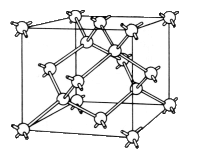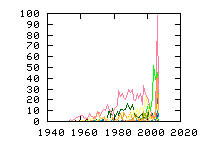« Previous
1
Next »
(9 hits, 1/1)
Showing
10, 25, 50, 100, 500, 1000, all papers per page.
Sort by:
last publication date,
older publication date,
last update date.
- 1. Phys. Rev. B 71, 115204 (2005) , “Electron Spin Resonance Study of Paramagnetic Centers in Neutron-Irradiated Heat-Treated Silicon”, D. Pierreux and A. StesmansElectron spin resonance (ESR) was used to study neutron-induced defects in silicon as functions of anneal temperature Tan. For Tan below 200 °C, the ESR response is dominated by the Si-P3 and Si-P6 spectra, as observed before. At Tan=200 ... (Read more)
- 2. Mater. Sci. Eng. B 36, 77 (1996) , “New Oxygen-Related EPR Spectra in Proton-Irradiated Silicon”, Kh. A. Abdullin, B. N. Mukashev, A. M. Makhov and Yu. V. GorelkinskiiAn electron-paramagnetic resonance (EPR) study of proton-irradiated silicon has revealed two new EPR spectra labeled Si-AA13 and Si-AA14. Spectrum AA13 has C3v symmetry (g = 1.9985 and g = 2.0024 ± 0.0002), AA14 C1 symmetry. These spectra correspond to positive (B+) and negative (B−)... (Read more)
- 3. Semicond. Sci. Technol. 11, 1696-1703 (1996) , “Metastable oxygen - silicon interstitial complex in crystalline silicon”, Kh. A. Abdullin, B. N. Mukashev, Yu. V. Gorelkinskii.A new metastable complex in monocrystalline silicon irradiated at with protons has been studied. Electron paramagnetic resonance (EPR) Si-AA13 ( symmetry) and Si-AA14 ( symmetry) spectra as well as the known Si-A18 spectrum originate from different molecular configurations of the complex. A... (Read more)
- 4. Phys. Rev. B 47, 6363-6380 (1993) , “Electron paramagnetic resonance of multistable interstitial-carbonsubstitutional-group-V-atom pairs in silicon”, X. D. Zhan, G. D. WatkinsA total of five new electron paramagnetic resonance (EPR) centers are observed in electron-irradiated P-, As-, and Sb-doped silicon. Three are identified as arising from the neutral charge state of the stable configuration and two of the four metastable configurations of an... (Read more)
- 5. Physica B 170, 155-167 (1991) , “Electron paramagnetic resonance of hydrogen in silicon ”, Yu.V. Gorelkinskii, N.N. Nevinnyi
- 6. Phys. Rev. B 35, 1582 (1987) , “Electronic and Atomic Structure of the Boron-Vacancy Complex in Silicon”, M. Sprenger, R. van Kemp, E. G. Sieverts, and C. A. J. AmmerlaanIn electron-irradiated boron-doped silicon the electron paramagnetic resonance spectrum Si-G10 has been studied. Earlier this spectrum had tentatively been identified with a boron-vacancy complex in a next-nearest-neighbor configuration. With electron-nuclear double resonance the hyperfine and... (Read more)
- 7. phys. stat. sol. (a) 92, K53 (1985) , “Low Symmetry Centre in Silicon”, A. V. Dvurechenskii, V. V. Suprunchik.Investigation of the defect formation in heavily doped silicon irradiated by high dose of electrons have led to the discovery of new types of defects /1, 2/. The present note is the next one of this series. A new centre is investigated in p-type silicon irradiated by neutrons. (Read more)Si| EPR neutron-irradiation| A5 C1 H8 P3 P6 Sii Vsi interstitial p-type triclinic vacancy .inp files: Si/H8/H8.inp | last update: Takahide Umeda
- 8. Phys. Lett. A 99, 117 (1983) , “Low-Symmetry EPR Center in Hydrogen-Implanted Silicon”, Yu.V. Gorelkinskii, N.N. NevinnyiA new S = 1/2 EPR spectrum, labeled Si-AA2, arises from a negative-charge-state defect which has a low symmetry(C1). It is produced in crystalline silicon by hydrogen implantation at ≈20°C followed by annealing at ≈580°C and disappears completely at 700°C. The kinetics... (Read more)Si| EPR ion-implantation| 29Si AA2 C1 Hydrogen Si-H Vsi cluster(>3) p-type triclinic vacancy .inp files: Si/AA2/AA2.inp | last update: Takahide Umeda
- 9. Sov. Phys. JETP 31, 677-679 (1970) , “Electron Paramagnetic Resonance in Plastically Deformed Silicon”, V. A. Grazhulis, Yu. A. Osipyan.Lightly doped silicon crystals were investigated experimentally by the electron paramagnetic resonance method. Paramagnetic centers, generated during plastic deformation of these crystals, were detected. The concentration of these centers increased monotonically with increasing degree of deformation. The EPR spectrum of these centers was anisotropic and had a partially resolved fine structure. The centers werestrongly annealed only at temperature T ≧ 600ºC and the activation energy of the annealing process was ~2 eV. It was concluded that these centers were due to electrons of broken bonds in the cores of dislocations with edge components.
« Previous
1
Next »
(9 hits, 1/1)
Showing
10, 25, 50, 100, 500, 1000, all papers per page.
Sort by:
last publication date,
older publication date,
last update date.
All papers (3399)
Updated at 2010-07-20 16:50:39
Updated at 2010-07-20 16:50:39
(view as: tree
,
cloud
)
| 1329 | untagged |
Materials
(111 tags)
Others(101 tags)
Technique
(46 tags)
Details
(591 tags)
Bond(35 tags)
Defect(interstitial)(18 tags)
Defect(vacancy)(15 tags)
Defect-type(19 tags)
Element(65 tags)
Energy(8 tags)
Isotope(56 tags)
Label(303 tags)
Sample(17 tags)
Spin(8 tags)
Symmetry(15 tags)

